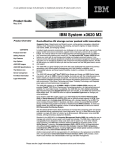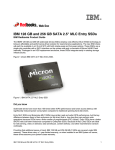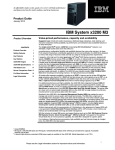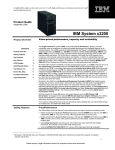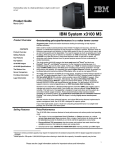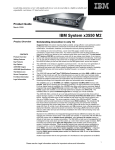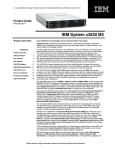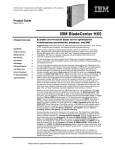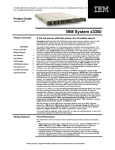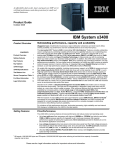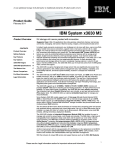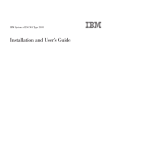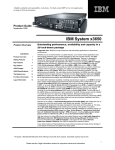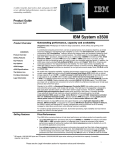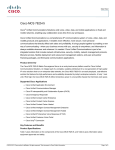Download IBM X3400 M2 User's Manual
Transcript
The engine of growth for your emerging businesses. Product Guide May 2009 IBM System x3400 M2 IBM System x3400 M2 provides flexible capabilities and outstanding performance that drives affordable business growth Product Overview [Suggested uses: Small/medium businesses, large multilocation enterprises and bank branch offices seeking scalability, top performance and availability features at an entry-level price.] CONTENTS Product Overview 1 Selling Features 1 Key Features 3 Key Options 9 x3400 M2 Images 12 x3400 M2 Specifications 13 The Bottom Line 15 Server Comparison Table 16 For More Information 17 Legal Information 17 The dual-socket IBM® System x3400 M2, incorporating IBM X-Architecture™ features, provides outstanding value to workgroups by combining scalable performance and availability features at an outstanding price. The x3400 M2 supports the latest quad- and dual-core Intel® Xeon™ 5500 series (Nehalem) processors, designed with up to 1066MHz memory access and 8MB (4-core) or 4MB (twocore) of L2 cache and Hyper-Threading Technology, to help provide you with the computing power you need to match your business needs and growth. In addition, the x3400 M2 supports industry-standard registered DDR-3 memory with Chipkill™ ECC (Error Checking and Correcting) protection—for high performance, energy savings, and reliability. For even higher levels of availability, the x3400 M2 also offers memory mirroring. A dual-port integrated high-speed Gigabit Ethernet controller is standard, as are high-performance PCIe adapter slots and a legacy PCI-32 slot to support legacy expansion cards. All models offer impressive scalability, including dual-processor support and up to 96GB of memory. Some models support eight high-performance 2.5-inch hot-swap Serial-Attach SCSI (SAS) HDDs with an internal storage capacity of up to 2.4TB. Other models support up to four 3.5-inch simple-swap Serial ATA II (SATA II) hard disk drives with a total capacity of up to 3.0TB1, or up to four 3.5-inch highperformance hot-swap Serial-Attach SCSI (SAS) drives with an internal storage capacity of 1.2TB, or up to four hot-swap SATA II hard disk drives with a total capacity of up to 4.0TB. For additional performance and high availability, the hot-swap x3400 M2 models include an IBM ServeRAID®-BR10i controller, providing RAID-0/1/1E support. Additional RAID support is available via the optional IBM ServeRAID™ family of SAS/SATA controllers, which support RAID-1/1E/10/5/6, and even full-drive hardware encryption. The x3400 M2 ships as a tower unit; CTO models can be ordered as a 5U rack-mounted server to help save precious data center floor space. Standard in the x3400 M2 is an Integrated Management Module (IMM) that enables users to manage and control the server easily—both locally and, using an optional Virtual Media Key, remotely. Unified Extensible Firmware Interface (UEFI) is an evolutionary leap over legacy BIOS. This high level of manageability is designed to keep costs down and the system up—even when network usage increases. These advanced features help maximize network availability by increasing uptime, as do hotswap/redundant HDDs; Active Memory™; temperature-controlled fans with Calibrated Vectored Cooling™; industry-standard IPMI 2.0 support, including highly secure remote power control and Serial over LAN; as well as text-console redirect over LAN. With the inclusion of unique IBM service and support features such as IBM Systems Director, IBM Systems Director Active Energy Manager, ServerGuide™, and the IMM, the x3400 M2 is equally well designed for a locally managed data center environment as for a remotely managed or stand-alone environment, while offering maximum availability. For a balance of high-performance dual-core, dual-socket processing, high availability and vast internal SAS storage at a budget price, the x3400 M2 is the ideal system. Selling Features Price/Performance The x3400 M2 offers numerous features to boost performance and reduce product and operating costs: • Up to two 4-core Xeon 5500 Series processors and 8MB or 4MB of shared cache per processor, offer superior performance capable of tackling the toughest jobs. 64-bit extensions provide the flexibility to run 32-bit and 64-bit applications concurrently. Xeon 5500 series processors offer up to 225% better performance than the previous-generation 5400 series processors and up to 900% better performance 1 GB equals 1,000,000,000 bytes and TB equals 1,000,000,000,000 bytes when referring to hard disk drive capacity. Accessible capacity may be less. Please see the Legal Information section for important notices and information. 1 The engine of growth for your emerging businesses. than the single-core processors of a few years ago that you may still be using. • Twelve DIMMs of fast registered 1066MHz (or 800MHz) DDR3 ECC memory with Chipkill2 protection (optional) provides speed, high availability, and a memory capacity of up 96GB. • Four high-speed PCIe Gen 2 adapter slots offer investment protection by supporting highperformance adapters, such as 10Gb Ethernet, Fibre Channel and InfiniBand cards, none of which will run in older conventional PCI slots. A legacy PCI/33 adapter slot offers support for older adapters. • Support for up to four 3.5-inch hot-swap SAS or SATA II hard disk drives or up to eight 2.5-inch hotswap SAS drives offer high-performance with high availability. The SAS controller provides full-duplex (2 x 300MBps) data transfers for SAS drives. For lower cost and high capacity, other models support up to four simple-swap SATA II drives. • The integrated dual-port Gigabit Ethernet controller with IPMI 2.0 support provides high-speed network communications, as well as TOE, RDMA, and iSCSI support to offload work from the system processor. (Note: iSCSI/RDMA support requires an optional license key.) • A high degree of device integration, including SAS/SATA, Gigabit Ethernet, systems management and video controllers, lowers costs and frees up valuable adapter slots. • Energy-efficient components, including low-voltage transistors and voltage regulator modules, and power supplies that are up to 90% efficient, help keep your energy bills down. Flexibility The x3400 M2 has the ability to grow with your application requirements, thanks to: • A choice of dual-core or quad-core processors starting at 1.86GHz and up to 2.53GHz clock rates, up to 5.86 gigatransfers per second, and 80W maximum power draw. • Up to 96GB of high-speed registered DDR-3 system memory. • Five available high-performance PCIe adapter slots and one legacy PCI slot in all models. Optionally, a riser card supporting two PCI-X/133 adapters or one additional PCIe can be selected via Configure-to-Order (CTO) models. • Installing the ServeRAID-MR10i option upgrades the basic RAID functionality with 256MB of low-cost, battery-backed cache to enable high-performance hardware RAID support, and allows the x3400 M2 to offer eight RAID levels: RAID-0, 1, 10, 1E, 5, 50, 6, and 60. The optional ServeRAID-MR10M controller supports up to four IBM System Storage™ EXP3000 expansion units containing up to 48 SAS HDDs and 14.4TB of external storage. If you require full data encryption, the ServeRAID-MR10is offers that in addition to the same RAID levels. • The eight USB 2.0 ports (six external, two internal) are up to 40X faster3 than older USB 1.1 ports. This provides speedy access to external HDDs (non-arrayed), floppy drives, flash drives, optical drives, tape drives, and other USB devices. Two ports are on the front of the unit and four are on the back. • Up to four internal 3.5-inch simple-swap SATA, hot-swap SAS or SATA HDDs, or up to eight 2.5inch SAS drives, plus a half- or full-high tape drive. This translates into as much as 4TB of internal SATA, 2.4TB of internal 2.5-inch SAS or 1.2TB of 3.5-inch SAS storage, providing tremendous internal storage capability, along with full data backup. Manageability Powerful systems management features simplify local and remote management of the x3400 M2: • UEFI — The Unified Extensible Firmware Interface is the next generation of BIOS, providing greater manageability and function. Used in PCs for several years, it is now moving into the server arena. IBM is the first to incorporate UEFI in our new servers. Features include: Human readable event logs — no more beep codes Complete out-of-band coverage by the Advance Settings Utility to simplify remote setup A complete setup solution, allowing adapter configuration functions to be moved into UEFI Consistent firmware management across an entire product line • The x3400 M2 includes the IMM to monitor server availability, perform Predictive Failure Analysis, etc., and trigger IBM Systems Director alerts. The IMM enables service personnel to use sophisticated diagnostic tools to resolve problems quickly. • Integrated IPMI 2.0 support alerts IBM Systems Director to anomalous environmental factors, such as voltage and thermal conditions. It also supports highly secure remote power control using data encryption. • Text Console Redirection support allows the administrator to remotely view x3400 M2 text messages over Serial or LAN. 2 3 All models require Chipkill-enabled DIMMs for Chipkill protection. Data transfer rates may be less than the maximum possible. Please see the Legal Information section for important notices and information. 2 The engine of growth for your emerging businesses. • Integrated Trusted Platform Module (TPM) 1.2 support. • The completely redesigned IBM Systems Director is included for proactive systems management. IBM Systems Director comes with a portfolio of tools, including Active Energy Manager, and Service and Support Manager. In addition, IBM Systems Director offers extended systems management tools for additional server management and increased availability. When a problem is encountered, IBM Systems Director can issue administrator alerts via e-mail, pager, and other methods. • IBM Systems Director Active Energy Manager™, an IBM-exclusive, is designed to take advantage of new system power management features, by providing power monitoring and power capping features. • The optional Virtual Media key provides IMM remote presence and it does this without consuming a valuable adapter slot. Availability and Serviceability The x3400 M2 provides many features to simplify serviceability and increase system uptime: • x3400 M2 servers offer Chipkill ECC memory protection4 (when using x4 DIMMs). Chipkill memory is up to 16X better than standard ECC memory at correcting memory errors. This can help reduce downtime caused by memory errors. • The x3400 M2 offers memory mirroring for redundancy in the event of a non-correctable memory failure • Toolless cover removal provides easy access to upgrades and serviceable parts. Similarly, the optional IMM Virtual Media Key and the ServeRAID-BR10i controller can be installed and serviced without tools. This means less time (and therefore less money) spent servicing the x3400 M2. Additionally, hot-swap/redundant HDDs, as well as mirrored memory, mean greater system uptime while these components are being serviced. • Environmental monitoring with fan speed control for temperature, voltages, fan failure, power supply failure, and power backplane failure. • IPMI 2.0 supports highly secure remote system power control using data encryption. This allows an administrator to restart a server without having to visit it in person, saving travel time and getting the server back up and running quickly and securely. It also adds new features to those provided by IPMI 1.5, including VLAN support, Serial over LAN, enhanced authentication and encryption algorithms (RMCP+, SHA-1, AES) and a firmware firewall. • Temperature-controlled fans adjust to compensate for changing thermal characteristics. At the lower speeds they draw less power and suffer less wear. Equally important in a crowded data center, temperature-controlled fans produce less ambient noise in the data center than if they were constantly running at full speed. • The three-year (parts and labor) limited onsite warranty5 offered on Machine Type 7836 helps afford you peace of mind and greater investment protection than a one-year warranty does. Key Features High-Performance Xeon Processors The x3400 M2 supports up to two high-performance Intel Xeon processors, allowing you to upgrade to a second processor as business needs require. The x3400 M2 offers a choice of processor clock rates, memory access speeds and power draw: • 80W quad-core Xeon 5500 Series processor standard performance models E5540, E5530 or E5520 at 2.53, 2.4 or 2.26GHz (respectively) running 5.6GT with 8MB of L3 processor cache, 1066MHz memory access, and Intel Turbo Boost technology. • 80W quad-core Xeon 5500 Series processor standard performance models E5504 at 2.0GHz running 4.86GT with 4MB of L3 processor cache, with 800MHz memory access. • 80W dual-core Xeon 5500 Series processor standard performance models E5502 at 1.83GHz running 4.86GT with 4MB of L3 processor cache, with 800MHz memory access. With the Xeon 5500 Series processors, Intel has diverged from its traditional Symmetric Multiprocessing (SMP) architecture to a Non-Uniform Memory Access (NUMA) architecture. The Xeon 5500 processors are connected through a serial coherency link called QuickPath Interconnect (QPI). QPI is capable of 6.4, 5.6 or 4.8 GT/s (gigatransfers per second), depending on the processor model. Quad-core Xeon processors contain four complete processor cores. Processors contain one unified 8MB L3 cache. The cache is dynamically allocated between the cores as needed. The multiple cores appear to software as multiple physical processors. Quad-core processors offer considerably higher performance than a same-speed Xeon processor with dual cores. 4 5 Chipkill protection is supported with x4 DDR-3 DIMMs, but not x8 DIMMs. For terms and conditions or copies of the IBM Statement of Limited Warranty, call 800-772-2227 in the U.S. In Canada call 800426-2255. Telephone support may be subject to additional charges. For warranties including onsite labor, a technician is sent after IBM attempts to resolve the problem remotely. International warranty service is available in any country in which this product is sold. Please see the Legal Information section for important notices and information. 3 The engine of growth for your emerging businesses. Turbo Boost Technology dynamically turns off unused processor cores and increases the clock speed of the cores in use, by up to two model frequencies. For example, with three cores active, a 2.26GHz processor can run the cores at 2.4GHz. With only one or two cores active, the same processor can run those cores at 2.53GHz. Similarly, a 2.93GHz processor can run at 3.06GHz or even 3.33GHz. When the cores are needed again, they are dynamically turned back on and the processor frequency is adjusted accordingly. Intelligent Power Capability powers individual processor elements on and off as needed, to reduce power draw. Execute Disable Bit functionality can help prevent certain classes of malicious buffer overflow attacks when combined with a supporting operating system. DDR-3 Registered Memory with Chipkill ECC Protection The x3400 M2 ships with registered double data rate III (DDR-3) memory and provides Active Memory features, including advanced Chipkill memory protection (optionally), for up to 16X better error correction than standard ECC memory. In addition to offering better performance than DDR-2 or fully-buffered memory, DDR-3 memory also uses less energy. DDR-2 memory already offered up to 37% lower energy use than fully buffered memory. Now, a generation later, DDR-3 memory is even more efficient, using 22% less energy than DDR-2 memory. The x3400 M2 supports up to 96GB of memory in twelve DIMM slots. Redesign in the architecture of the Xeon 5500 series processors bring radical changes in the way memory works in these servers. For example, the Xeon 5500 series processor integrates the memory controller inside the processor, resulting in two memory controllers in a 2-socket system. Each memory controller has three memory channels. Depending on the type of memory, population of memory, and processor model, the memory may be clocked at 1066MHz or 800MHz. Xeon 5500 Processor 0 Xeon 5500 Processor 1 QPI Memory Controller Ch0 Ch1 4 1 D2 D3 Ch2 5 2 D5 D6 Memory Controller Ch0 6 3 D7 D8 Ch1 10 7 D10 D11 Ch2 11 8 D13 D14 12 9 D15 D16 1-12: DIMM population sequence; D1-D12: DIMM slot assignments Note: If only one processor is installed, only the first six DIMM slots can be used. Adding a second processor not only doubles the amount of memory available for use, but also doubles the number of memory controllers, thus doubling the system memory bandwidth. If you add a second processor, but no additional memory for the second processor, the second processor has to access the memory from the first processor “remotely,” resulting in longer latencies and lower performance. The latency to access remote memory is almost 75% higher than local memory access. So, the goal should be to always populate both processors with memory. The E552x-and-up models support up to 1066MHz clock speed, and the E550x models support 800MHz clock speed. Using 1066MHz memory (where supported) versus 800MHz offers up to 28% better performance. Xeon 5550 series processors access memory with almost 50% lower latency than the previous generation 5400 series processors. That can result in faster processing of latency-sensitive workloads. This new processor design comes with some trade-offs in memory capacity, performance, and cost: For example, greater memory capacity comes with lower memory speed. Alternatively, it is possible to achieve the same memory capacity at lower cost but at a lower memory speed. Regardless of memory speed, the Xeon 5500 platform represents a significant improvement in memory bandwidth over the previous Xeon 5400 platform. This improvement is mainly due to the dual integrated memory controllers and faster DDR-3 memory. Throughput at 800MHz is 25 gigabytes per second (GBps), and at 1066MHz it’s 32GBps. This improvement translates into improved application performance and scalability. Memory interleaving refers to how physical memory is interleaved across the physical DIMMs. A balanced system provides the best interleaving. A Xeon 5500 processor-based system is balanced when all Please see the Legal Information section for important notices and information. 4 The engine of growth for your emerging businesses. memory channels on a socket have the same amount of memory. A memory rank is simply a segment of memory that is addressed by a specific address bit. DIMMs typically have 1, 2 or 4 memory ranks, as indicated by their size designation. • A typical memory DIMM description is 2GB 4Rx8 DIMM • The 4R designator is the rank count for this particular DIMM (R for rank = 4) • The x8 designator is the data width of the rank It is important to ensure that DIMMs with appropriate number of ranks are populated in each channel for optimal performance. Whenever possible, it is recommended to use dual-rank DIMMs in the system. Dual-rank DIMMs offer better interleaving and hence better performance than single-rank DIMMs. For instance, a system populated with six 2GB dual-rank DIMMs outperforms a system populated with six 2GB single-rank DIMMs by 7% for SPECjbb2005. Dual-rank DIMMs are also better than quad-rank DIMMs because quad-rank DIMMs will cause the memory speed to be down-clocked. Another important guideline is to populate equivalent ranks per channel. For instance, mixing one singlerank DIMM and one dual-rank DIMM in a channel should be avoided. Note: It is important to ensure that all three memory channels in each processor are populated. The relative memory bandwidth decreases as the number of channels populated decreases. This is because the bandwidth of all the memory channels is utilized to support the capability of the processor. So, as the channels are decreased, the burden to support the requisite bandwidth is increased on the remaining channels, causing them to become a bottleneck. For increased availability, the x3400 M2 offers an additional (but mutually exclusive) level of IBM Active Memory protection: online memory mirroring. Memory mirroring works much like disk mirroring. The total memory is divided into two channels. Data is written concurrently to both channels. If a DIMM fails in one of the DIMMs in the primary channel, it is instantly disabled and the mirrored (backup) memory in the other channel becomes active (primary) until the failing DIMM is replaced. One-half of total memory is available for use with mirroring enabled. (Note: Due to the double writes to memory, performance is affected.) Mirroring is handled at the hardware level; no operating system support is required. DDR-3 memory is available in 1GB, 2GB, 4GB and 8GB DIMMs. DIMMs are installed individually (not in pairs). Hot-Swap/Redundant Components System availability is maximized through the extensive use of hot-swap and redundant components, including: • Redundant memory protection (with memory mirroring enabled) and Chipkill protection • Hot-swap, redundant hard disk drives (with RAID-1/10 protection standard, and RAID-1E/5/6 protection optional) Large HDD Storage Capacity The x3400 M2 offers a choice of disk storage, supporting up to four 3.5-inch hot-swap or simple-swap Serial ATA (SATA) drives, four 3.5-inch hot-swap high-performance Serial-Attach SCSI (SAS) drives or eight 2.5-inch hot-swap SAS drives: 3.5-inch SAS • 15,000 RPMs — 73.4, 146.8, or 300GB (2.4TB maximum) 2.5-inch SAS • 10,000 RPMs — 146.8 or 300GB (2.4TB) • 15,000 RPMs — 73.4 or 146.8GB (1.17TB) 3.5-inch SATA—Hot-Swap • 10K RPMs — 160, 250, 500, 750GB or 1TB (4.0TB) 3.5-inch SATA—Simple-Swap • 10K RPMs — 160, 250, 500 or 750GB (3.0TB) Notes: Hot-swap and simple-swap SATA drives offer exactly the same reliability as fixed SATA drives. Only the system availability improves using the swappable drives. (Less downtime is incurred removing and installing the drives.) Hot-swap SAS drives use the Converged Tray for interchangeability with other IBM System x™ systems. Please see the Legal Information section for important notices and information. 5 The engine of growth for your emerging businesses. Drive Bays The x3400 M2 contains either 11 drive bays (in 2.5-inch models) or 7 bays (in 3.5-inch) models. 2.5-inch models support small form-factor (SFF) hot-swap SAS drives. 3.5-inch models support four hot-swap SAS or SATA II drives, or simple-swap SATA II drives. In addition, there are three 5.25-inch bays. An internal full-high tape drive can be installed using two of the 5.25-inch drive bays; alternatively, an internal half-high tape drive can be installed using one of the 5.25-inch drive bays. The tape drive must have a USB 2.0 interface. A half-high DVD-ROM drive with a SATA interface ships standard in the other 5.25-inch bay. An external USB floppy drive may be used, if needed. Hot-swap drives may be inserted or removed through the front of the server without powering off the system. Simple-swap drives may also be installed and removed through the front, but requires powering off the server first. For still more storage, a direct-attach, NAS or SAN external expansion option can be added, using an optional controller. Disk/Tape Controllers All hot-swap x3400 M2 models include an integrated hardware-based IBM ServeRAID-BR10i SAS/SATA controller. This controller supports up to eight internal SAS or SATA drives. (Simple-swap models use the SATA support incorporated in the system chipset.) The integrated ServeRAID-BR10i controller offers hardware RAID-0/1/1E support. The controller provides data transfer speeds of up to 3Gbps6 per SAS port on an 8-lane 2.5 Gbps PCIe card. It supports both SAS and SATA HDDs, as well as Solid-State Drives (SSDs) and tape drives. The x3400 M2 also supports full RAID-0/1/10/1E/5/6 support using the optional ServeRAID-MR10i card. It also offers higher performance, due to the 256MB battery-backed onboard cache. The x3400 M2 also supports hardware based full-disk encryption with RAID-0/1/10/1E/5/6 support using the optional ServeRAID-MR10is Vault card. For external storage, the ServeRAID-MR10M controller enables connection to up to four IBM System Storage EXP3000 SAS expansion units (48 HDDs total). It provides RAID-0/1/10/5/50 support and 256MB of onboard cache. Internal Backup The x3400 M2 supports several internal tape backup options. Supported technologies include: • DDS-5 (half-high) • DDS-6 (half-high) • GoVault internal dock (half-high) • LTO-3 Ultrium (half-high) • LTO-4 Ultrium (half-high) High-Performance Adapter Slots The x3400 M2 provides six adapter slots in all, including one x16 (“by 16”) physical/x8 electrical PCIe (PCI Express) Gen 2 full-length/full-height adapter slot (Slot 2). This means that although the slot runs at x8 Gen 2 speeds (8GBps), it can accept a x16 Gen 2 adapter in the slot. It is also capable of supporting x1/x4/x8 adapters at full speed. In addition to this slot, the x3400 M2 also includes two x8 physical/x8 electrical Gen 2 slots (8GBps), two x8 physical/x4 electrical Gen 2 slots (4GBps), and one 33MHz legacy PCI slot. As part of a configure-to-order (CTO) build two choices of PCIe riser card can be added, with either two 133MHz PCI-X slots or one PCIe x8 physical/x4 electrical Gen 1 slot (2GBps). Slot 1 is a half-length/full-height PCIe slot; slots 2, 3, 4 and 5 are full-length/full-height PCIe slots, and Slot 6 is a half-length/full-height 33MHz legacy PCI slot. The PCI-X riser contains two fulllength/full-height slots (5 and 6). PCI Express is a high-performance, low-latency, next-generation serial I/O bus that is rapidly replacing the older parallel PCI and PCI-X buses. A x16 PCIe Gen 2 adapter offers approximately sixteeen times the maximum throughput of a 133MHz PCI-X adapter7. (A x1 Gen 1 adapter offers throughput similar to a 66MHz PCI-X slot.) Dual-Port Gigabit Ethernet Controller The x3400 M2 includes one dual-port integrated Broadcom 5709C Gigabit Ethernet controller for up to 10X higher maximum throughput than a 10/100 Ethernet controller, as well as support for PXE 2.0 6 7 Data transfer rates depend on many factors and are often less than the maximum possible. Actual throughput will depend on the adapter vendor’s implementation. Please see the Legal Information section for important notices and information. 6 The engine of growth for your emerging businesses. remote boot, TCPIP Offload Engine (TOE), Internet SCSI (iSCSI), Remote Direct Memory Access (RDMA), and jumbo frames (9KB). A license key is required to enable the iSCSI and RDMA features. Jumbo Frames—those larger than the standard frame (packet) size of 1,500 bytes—can be more efficient, dramatically increasing network performance and reducing server CPU overhead. TOE helps improve overall system performance by offloading TCP/IP protocol processing from the system microprocessor to the onboard Ethernet TOE processor. There is no additional charge for this capability. It also supports highly secure remote power management using IPMI 2.0, plus Wake on LAN® and PXE (Preboot Execution Environment) flash interface. Optional PCIe adapters offering failover and load balancing between adapters are available for added throughput and increased system availability. Integrated Ethernet ports: • 3 Gb RJ45 Ethernet ports, ideal for virtualization and I/O-intensive workloads • 2 ports standard for Gb Ethernet and plus 1 dedicated Fast Ethernet port for systems management • Improves system performance by offloading protocol processing from CPU to a separate TOE engine • Primary performance improvement for data copying (CPU) where CPU utilization is 90-100% • The embedded NIC/TOE supports software iSCSI using a Microsoft iSCSI initiator • Using a software initiator enables offloading the processing of TCP frames with the TOE engine in the adapter card, but the processing of iSCSI packets themselves is not hardware-offloaded at the Broadcom NIC • Broadcom hardware-offloaded iSCSI (using TOE engine) of the iSCSI frames Onboard Broadcom 5709C Gigabit Ethernet controller provides two Gigabit ports supporting IEEE 802.3 for 1000Base-T, 100Base-TX, and 10Base-T applications (802.3, 802.3u, 802.3ab) over a CAT 5 twistedpair cable. TOE support on Windows is available today, but requires the Windows Scalable Network Pack (SNP) installed. Linux has no plan to support TOE at this time. Please refer to TOE_RDMA_iSCSI.doc for technology details. Internet Protocol version 6 (IPv6) is supported. Ultra-Efficient Cooling Strategically located fans, combined with efficient airflow paths, provide highly effective system cooling for the x3400 M2, known as Calibrated Vectored Cooling. The server includes three hot-swap fans (plus another in the power supply). The system contains three cooling zones. Zone 1 cools the memory slots and the three 5.25-inch drive bays. Zone 2 cools the processors, while Zone 3 cools the adapter slots and the HDD bays. The fans automatically adjust speeds in response to changing thermal requirements, depending on the zone, redundancy, and internal temperatures. When the temperature inside the server increases, the fans speed up to maintain the proper ambient temperature. When the temperature returns to a normal operating level, the fans return to their default speed. Why not simply run the fans at 100% capacity all the time? For several good reasons: to reduce the ambient noise, reduce the wear-and-tear on the fans and reduce the server power draw. The reduction in ambient noise and power draw may be relatively minor for a single server, but put dozens or hundreds in a data center and it can make a big difference! In addition, the server uses hexagonal ventilation holes in the chassis. Hexagonal holes can be grouped more densely than round holes, providing greater airflow through the system cover. This cooling scheme is important because newer, more powerful processors generate a significant amount of heat, and heat must be controlled for the system to function properly. Other Features • Eight USB 2.0 ports — Provides flexibility to add high-speed external devices. The USB 2.0 specification supports up to 480Mbps transfer rates. (Note: Not all USB 2.0 devices are capable of achieving this rate.) Two ports are provided on the front of the server, four are on the back, one is internal to support a USB-interface tape drive, and one is internal to support a USB flash drive for an embedded hypervisor. • Embedded hypervisor; a USB port on the motherboard, activated with an optional 2GB USB key for supporting VMWare ESXi for virtualization • IMM Virtual Media Key — This optional feature adds local and remote management functions without consuming a valuable adapter slot. • Toolless chassis — The cover can be opened without tools, and many components can be removed and replaced without tools, including the CD-RW/DVD combo drive, hot-swap drives, and PCIe/PCI-X adapters, as well as the integrated ServeRAID-BR10i controller, embedded hypervisor key, and IMM Virtual Media Key. This can save a servicer significant time. Please see the Legal Information section for important notices and information. 7 The engine of growth for your emerging businesses. Rack Cable Management and KVM Console Switching IBM Advanced Cabling Technology (ACT) is an optional feature that offers many advantages over standard KVM cabling across the entire System x product line. So now you can interconnect all of your servers with one smart cabling architecture. ACT cabling eliminates the need for one-to-one direct connections between each server and a KVM switch by using a daisy-chain approach. The snarl of cabling behind most racks is at best inconvenient to work around and at worst an expensive logistical nightmare, requiring the rewiring of servers, PDUs, KVM switches, and other equipment whenever a rack server is added or removed. Even worse, the veil of cables blocks rack airflow and can actually contribute to equipment failure due to overheating. ACT cabling is the solution for reducing behind-the-rack cabling by as much as 87%. The illustration below shows a sample ACT configuration: Directly Via Daisy-Chain • Max.16 servers per port All CAT5, 5e, 6 cabling Via Secondary Switch Conventional cabling has bulky KVM cables exiting each server, which then connect to a KVM switch. The cables exiting a series of KVM switches must then be aggregated via additional KVM switches and PDUs, which only increases the number—and cost—of cables, KVM switches and PDUs. Instead, the daisychain approach of ACT cabling uses readily available, inexpensive CAT5 and 6 cabling to considerably reduce the number of cables, KVM switches, and PDUs needed, rather than increasing them. If a server is removed or added, no complicated rewiring is needed. One cable connects the first server in the rack to the next, and so on. Up to 16 servers form a chain; up to 8 chains can connect to one Local Console Manager (LCM); 16 LCMs can connect to one Global Console Manager (GCM). In this manner, up to 2,048 servers can be centrally managed. Equally importantly, with ACT—unlike some other offerings— everything is done externally via cabling; no special adapters are required. Extensive System Support Features The IBM services and technical support portfolio provides world-class, consistent, high-quality service and support. The x3400 M2 server offers a number of tools and services designed to make ownership a positive experience. From the start, IBM programs make it easier for you to plan for, configure and purchase System x or xSeries servers, get them running and keep them running long-term. These features include IBM Express Portfolio, IBM ServerProven®, the IBM Standalone Solutions Configuration Tool, IBM System x and BladeCenter Power Configurator, IBM ServerGuide, IBM Systems Director Service and Support Manager, Product Customization Services and extensive technical support offerings. This System x server is part of the IBM Express Portfolio, designed, developed and priced to meet the specific needs of midsized businesses. The IBM Express Portfolio of solutions is easy to acquire, install and manage. And they leverage IBM technology to provide tangible solutions to help you solve business problems in an on demand world. The IBM ServerProven program provides the confidence that specific options and operating systems have been tested on the server and are officially supported to work together. It is updated frequently to ensure that the latest compatibility information is always at your fingertips. The IBM Standalone Solutions Configuration Tool (SSCT) is a downloadable tool that simplifies the often complex chore of configuring a full rack of servers (including blade servers) and confirming that you have all the cables, power distribution units, KVM (keyboard, video and mouse) switch boxes and other components you need, as well as the proper airflow clearances, electrical circuits and other environmental conditions. IBM System x and BladeCenter Power Configurator helps IT managers plan for data center power needs, by providing the following information for specific configurations of System x and BladeCenter Please see the Legal Information section for important notices and information. 8 The engine of growth for your emerging businesses. systems: power input (watts), PDU sizing (amps), heat output (BTUs), airflow requirements through chassis (CFM), VA rating, leakage current (mA), and peak inrush current (amps). IBM ServerGuide (installed from CD) simplifies the process of installing and configuring System x and xSeries servers. ServerGuide goes beyond mere hardware configuration by assisting with the automated installation of the Microsoft® Windows® Server 2000 and 2003 operating systems, device drivers and other system components, with minimal user intervention. (Drivers are also included for support of Novell NetWare, Red Hat Linux and SUSE LINUX.) This focus on deployment helps you reduce both your total cost of ownership and the complexity that administrators and technical personnel face. IBM Systems Director Service and Support Manager (previously called IBM Electronic Service Agent™) is an innovative “call home” feature that allows System x and BladeCenter servers to automatically report hardware problems to IBM support, which can even dispatch onsite service8 if necessary to those customers entitled to onsite support under the terms of their warranty or an IBM Maintenance Agreement. Electronic Service Agent resides on a server and provides electronic support and problem management capabilities through a highly secure electronic dialogue between your systems and IBM. It monitors networked servers for hardware errors and it can perform hardware and software inventories and report inventory changes to IBM. All information sent to IBM is stored in a highly secure database and used for improved problem determination. Additional services include hardware warranty upgrades and factory-installed Product Customization Services (PCS), such as asset tagging, hardware integration, software imaging and operating systems personalization. IBM offers extensive technical support by phone and via the Web. Support options include links to forums/newsgroups, problem submission, online shopping support, service offerings, device drivers for all IBM product lines, software downloads and even upcoming technical seminar worldwide schedules and registration. Also available are remote installation, configuration and usage support for System x and xSeries hardware and software, as well as onsite custom services to provide the level of expertise you require. Advanced Systems Management Capabilities The x3400 M2 has a high level of systems management capabilities that are well-suited to remote locations as well as to stand-alone environments. Features include UEFI, IMM, Tool Center, IBM Systems Director Active Energy Manager, Automatic Server Restart, Wake on LAN® support, PXE support, text console redirect, Predictive Failure Analysis, IBM Systems Director and support for an optional Remote Supervisor Adapter II SlimLine. The Integrated Management Module (IMM) provides industry-standard Intelligent Platform Management Interface (IPMI) 2.0-compliant systems management. It provides a number of important system functions, including: • Monitoring of system and battery voltage, system temperature, fans, power supplies, processor and DIMM status • Fan speed control • Product ID and Family ID detection • Highly secure remote power on/off • System reset control • NMI/SMI detection and generation • System diagnostic LED control (power, HDD, activity, alerts, heartbeat) • IPMI over LAN • Serial Over LAN • Proxy server support • LAN messaging and alerting • Text console redirection over LAN • VLAN support • Enhanced authentication and encryption algorithms (RMCP+, SHA-1, AES) • Local update of BMC firmware • Firmware firewall • Support for IPMI v2.0 compliant management software (e.g., xCAT) • Other mandatory and optional IPMI BMC functions The IMM alerts IBM Systems Director to anomalous environmental factors, such as voltage and thermal conditions—even if the server has failed. The x3400 M2 also supports an optional IMM Virtual Media Key for additional systems management 8 For onsite labor, IBM will attempt to diagnose and resolve the problem remotely before sending a technician. Please see the Legal Information section for important notices and information. 9 The engine of growth for your emerging businesses. capabilities, including: • Predictive Failure Analysis for system fans • Graphical console redirection over LAN • Web-based out-of-band control • Windows “blue screen” capture • Remote virtual floppy and CD-ROM • High-speed remote redirection of PCI video, keyboard and mouse • SSL (Secure Socket Layer) and LDAP (Lightweight Directory Access Protocol) support IBM developed IBM Systems Director Active Energy Manager to put control of system power-saving features at the fingertips of administrators. Active Energy Manager is designed to take advantage of new features, such as monitoring power usage and balancing the performance of the system according to available power input. It provides the ability to plan and predict power consumption based on your hardware configuration. It also helps enable you to reduce the infrastructure required for redundancy, by using fewer servers on smaller power feeds and potentially lowering your overall data center support costs. It does this by inventorying all components, then adding up the total power draw and tracking the usage. It also includes power management and capping features to help administrators manage or reduce power usage. Automatic Server Restart (ASR) helps reduce downtime by restarting the server automatically in the event of a system lockup. ASR technology is a combination of hardware circuitry tied into the server’s system reset function and a device driver. As long as the server continues running, the ASR watchdog timer will keep being reset, but if the operating system crashes or the hardware freezes somehow the ASR software will be unable to reset the hardware timer. If the timer is not reset within five minutes, it automatically triggers the ASR hardware, which immediately restarts the server (and logs an ASR event with IBM Systems Director). These features are designed so that no more than five minutes can pass before the server is restarted. Wake on LAN permits the server to be remotely powered on if it has been shut off. Once powered up, the server can be controlled across the network, using the Preboot Execution Environment (PXE). Like Wake on LAN, PXE is system firmware. It enables software such as the optional IBM Remote Deployment Manager to take control of a system before the BIOS, operating system or applications are loaded (using Wake on LAN/PXE) and lets an administrator perform many low-level tasks remotely that would otherwise require a visit to each system. These tasks may include such things as formatting a hard disk drive, updating system firmware, or deploying a Windows or Linux operating system. Text Console Redirection support allows the administrator to remotely view x3400 M2 text messages over serial or LAN. An optional IMM Virtual Media Key adds graphical console redirection. Predictive Failure Analysis (PFA) is designed to allow the system to detect impending failure of supported components (processor, memory, HDDs, fans, VRM, and power supplies) before actual failure, and alert the administrator through IBM Systems Director. This gives you the ability to replace the failing component before it fails, resulting in increased uptime. IBM Systems Director software for advanced workgroup management is included with the x3400 M2. IBM Systems Director comes with a portfolio of tools, including Systems Director Active Energy Manager, System and Support Manager, and other tools. System Availability (a no-charge download) and Capacity Manager (sold separately) are available as add-ons for additional server management and increased availability. IBM Systems Director provides a single uniform graphical interface for all of these systems management functions. IBM Systems Director enables you to customize thresholds and monitor system components (for things like temperature, voltage regulation, etc.) to help maximize uptime. Key Options IBM options for System x servers help you take your servers to a higher level You can rely on System x options to supply a complete solution for your business needs. Options help you create an optimized server system to meet your data protection, storage and availability needs. Every IBM option is designed and tested for peak performance and flexibility, helping to maximize your return on investment. The combination of System x servers and options lets you keep your fingers on the pulse of your e-business. Processors — The Intel Xeon processor provides high clock rates, four cores, 64-bit extensions, a large cache and advanced features for availability and manageability. Large cache size, combined with fast 1066MHz or 800MHz memory access and an integrated memory controller reduce memory latency and facilitates the movement of data. (Note: System performance depends not only on the number of processors in the server but also on the power and functionality of each processor.) Adding a second processor may be a cost-effective way to achieve significant performance improvements. Memory — Memory is a significant factor in systems application performance. Adding more memory to a System x server is one of the most effective ways to increase application performance. For best Please see the Legal Information section for important notices and information. 10 The engine of growth for your emerging businesses. performance in a server with a 4-core processor, there should be twice as much memory available as for a 2-core processor. Backup Drives — Backup drives help you protect your data. IBM offers several choices of capacities and technologies, including DDS-5, DDS-6, LTO-3, LTO-4, and GoVault. Hard Disk Drives — IBM hard disk drives help you improve the transaction and cost performance of your System x servers. The choice of hard disk drives can be a critical aspect of maximizing the I/O throughput of the system. SAS 2.5-inch hard disk drives are available for the x3400 M2 with capacities up to 300GB apiece at 10,000 RPMs or up to 146.8GB apiece at 15,000 RPMs. Power Supply — The optional second power supply for the x3400 M2 enables redundancy for hot-swap power. In addition, its 90%-efficient design helps lower your energy bill for power and cooling. IMM Virtual Media Key — The x3400 M2 includes a plethora of systems management features built-in. The optional IMM Virtual Media Key not only offers powerful new features, it does so without taking up a valuable PCIe or PCI-X adapter slot, instead using a dedicated connector on the motherboard. ServeRAID Controllers — System x servers using ServeRAID technology allow companies to build a reliable foundation for business-critical computing. IBM ServeRAID technology allows an array consisting of multiple physical hard disk drives to be treated as one logical drive. ServeRAID technology also allows data to be stored redundantly, across multiple hard disk drives— enhancing both the integrity and the availability of the data. SAS and SATA ServeRAID controllers offer enhanced performance due to onboard processors and cache. Because IBM ServeRAID controllers can help significantly improve data transfer rates, this technology is extremely effective when implementing demanding, transaction-oriented applications. By employing the advanced fault tolerance of IBM ServeRAID technology, companies can effectively implement networked business systems that require large amounts of storage space for data and applications that must be available for their businesses to continue operating. The optional ServeRAID-MR10i SAS/SATA controller offers enhanced performance over the integrated ServeRAID-BR10i controller (SAS models), 256MB of battery-backed cache memory, and supports eight RAID levels: 0 (striping), 1 (mirroring), 10 (mirroring and striping), 1E (enhanced mirroring, supporting odd numbers of drives), 5 (striping with parity), 50 (striping/mirroring with parity), 6 (striping with dual-parity), and 60 (striping/mirroring with dual-parity). The optional ServeRAID-MR10is supports hardware-based full disk encryption plus RAID0/1/1E/10/5/50/6/60 support. The optional ServeRAID-MR10M SAS controller offers high performance and 256MB of cache memory (with optional battery backup) for external SAS storage capacity. The adapter supports RAID0/1/10/5/50/6/60. External Storage — The IBM System Storage DS3000, DS4000, DS6000, and DS8000 series, as well as the N3000, N5000, and N7000 series, comprise a powerful and broad shared storage family with integrated management software designed to meet midrange and enterprise needs. For lower-end needs, IBM offers the System Storage DS400 storage enclosures. External SAN, iSCSI, and direct-attach storage is available using one of several IBM System Storage and TotalStorage host bus adapters. Additionally, external LAN-attached tape storage is available. Please see the Legal Information section for important notices and information. 11 The engine of growth for your emerging businesses. x3400 M2 Images Front View Rear View DVD-ROM Drive 2 Open 5.25” Drive Bays 2 USB 2.0 Ports (behind door) Power Supply Hexagonal Ventilation Holes Locking Drive Covers Serial Port Video Port Hexagonal Ventilation Holes Fast Ethernet Port for IMM Cover Lock Key 2 USB 2.0 Ports (internal) 8 Hot-Swap 2.5” SAS HDD Bays; or 4 HS 3.5” SAS/SATA Bays; or 4 SS 3.5” SATA Bays GB Ethernet Ports 4 USB Ports Adapter Slot Covers Interior View (3) 5.25-inch Drive Bays Fixed Power Supply 6 DIMM Sockets 6 DIMM Sockets (Hidden) CPU 1 CPU 1 Fans CPU 2 BCM5709 C Hypervisor USB Port Adapter Slots IMM UEFI (Hidden) (4) 3.5-inch or (8) 2.5-inch HDD Bays Please see the Legal Information section for important notices and information. 12 The engine of growth for your emerging businesses. x3400 M2 Specifications 7836-1xX/1xY, 2xX/2xY, 3xX/3xY, 4xX/4xY, 5xX/5xY (1 yr. warr.) Machine type Form factor 7837-1xX/1xY, 2xX/2xY, 3xX/3xY, 4xX/4xY, 5xX/5xY (3 yr. warr.) Tower (or 5U rack; CTO models only) BIOS type Unified Extensible Firmware Interface (UEFI) 4-Core Intel Xeon (E55xx) 2.0GHz E5504 (2xX/2xY), 2.26GHz E5520 (3xx/3xY), 2.4GHz E5530 (4xX/4xY), 2.53GHz E5540 (5xX/5xY) Processor type 2-Core Intel Xeon (E55xx) 1.86GHz E5502 (1xX/1xY), Maximum processor power draw 80W # of processors standard / maximum 1/2 Internal L2 cache 8MB (3xX/3xY, 4xX/4xY, 5xX/5xY) Chipset 4MB (1xX/1xY, 2xX/2xY) Intel 5520 Standard / maximum memory9 Standard memory type Maximum memory access speed 2GB (2 x 1GB) / 96GB Registered PC3-10600 (DDR III ECC (Chipkill protection when using x4 DIMMs); single-, dual-, or quad-rank 1066MHz (3xX/3xY, 4xX/4xY, 5xX/5xY) DIMM capacities supported 800MHz (1xX/1xY, 2xX/2xY) 1GB, 2GB, 4GB, 8GB # of DIMM sockets total / available 12 (6 per processor) / 10 Online spare memory supported / # of DIMM sockets reserved for sparing No Memory mirroring supported / # of DIMM sockets reserved for mirroring Yes / 12 (6 per processor) # of drive bays total / available # of HDD drive bays total / available 7 / 6 (12X/12Y, 22X/22Y, 24X/24Y, 32X/32Y, 42X/42Y, 44X/44Y) 11 / 10 (14X/14Y, 34X/34Y, 52X/52Y) 8 / 8 2.5-inch hot-swap SAS (14X/14Y, 34X/34Y, 52X/52Y) # of 5.25-inch bays total / available 4 / 4 3.5-inch hot-swap SAS or SATA (24X/24Y, 44X/44Y) 4 / 4 3.5-inch simple-swap SATA (12X/12Y, 22X/22Y, 32X/32Y, 42X/42Y) 3 / 2 (SATA DVD-ROM installed) Maximum HDD capacity standard 3.5-inch Hot-Swap SAS 1.2TB (4 x 300GB) 3.5-inch Hot-Swap SATA 4.0TB (4 x 1TB) 3.5-inch SimpleSwap SATA 3.0TB (4 x 750GB) 2.5-inch Hot-Swap SAS 2.4TB (8 x 300GB) HDD capacities supported 3.5-inch Hot-Swap SAS 73.4, 146.8, 300GB — 15K RPMs 3.5-inch Hot-Swap SATA 160, 250, 500, 750GB, 1TB — 10K RPMs 3.5-inch SimpleSwap SATA 160, 250, 500, 750GB — 10K RPMs 2.5-inch Hot-Swap SAS 146.8, 300GB — 10K RPMs; 73.4, 146.8GB — 15K RPMs Disk drive technology # of HDDs standard Hot-swap SAS/SATA Simple-swap SATA None # of optical drives standard 1 SATA DVD-ROM (in dedicated 5.25" bay) # of diskette drives standard None (USB-attach) Internal tape drives supported 9 One full-high (uses two 5.25” bays); One half-high (uses one 5.25” bay) Maximum memory and disk capacity may require the replacement of standard components with the largest supported component available. Please see the Legal Information section for important notices and information. 13 The engine of growth for your emerging businesses. x3400 M2 Specifications Integrated disk controller # of disk drives supported per port Optional RAID controllers supported External disk drives supported # of adapter slots total / available ServeRAID-BR10i (0MB cache standard)— internal SAS/SATA (RAID-0/1/1E)---hot-swap models Four-port integrated SATA—simple-swap models 1 ServeRAID-MR10i (256MB cache standard)—SAS/SATA (adds RAID-10/5/50/6/60); ServeRAID-MR10is Vault (256MB cache standard)—SAS/SATA (adds full drive hardware encryption) Yes, via ServeRAID-MR10M controller (256MB cache standard; RAID-0/1/10/5/50/6/60) 6 / 6 (7 via CTO) # of PCIe x16 Gen 2 physical/x8 Gen 2 electrical slots (8GBps) 1 full-height/full-length # of PCIe x8 Gen 2 physical/x8 Gen 2 electrical slots (8GBps) 2 full-height/full-length (1 slot reserved for RAID card in hot-swap models) # of PCIe x8 Gen 2 physical/x4 Gen 2 electrical slots (4GBps) 2 full-height/full-length # of PCIe x8 Gen 1 physical/x4 Gen 1 electrical slots (2GBps) None standard (1 optional via CTO, by adding a PCIe extender card) # of PCI-X/133 slots (1GBps) None standard (2 optional via CTO, by adding a PCI-X extender card) # of 33MHz legacy PCI slots 1 full-height/half-length # of video ports 1 Video controller Matrox G200eV (in IMM) Video memory 16MB DDR-2 SDRAM Maximum video resolution at 32-bit color 1600 x 1200 x 16-bit color at 85Hz Gigabit Ethernet controller 1 dual-port Broadcom BCM5709C (TOE, iSCSI, RDMA)—iSCSI/RDMA support requires license key # of Gigabit Ethernet ports 2 (rear) # of Fast Ethernet ports (via) IMM 1 (rear) # of RS485 ports None # of serial ports 1 (rear) # of parallel ports None (USB-attached) # of PS/2 mouse ports None (USB # of PS/2 keyboard ports None (USB # of USB 2.0 ports Integrated systems management controller 8 total; 6 external (2 front, 4 rear) ports, plus 1 internal connector for tape drive and 1 internal connector for an embedded hypervisor (on USB flash drive) Yes (IMM) Optional systems management controller None Light path diagnostics support No Predictive Failure Analysis support Power supply size # of power supplies standard / Processors, memory, HDDs, VRMs, fans, and power supplies 670W universal, autoswitching 1 / 1 (nonredundant) Please see the Legal Information section for important notices and information. 14 The engine of growth for your emerging businesses. x3400 M2 Specifications maximum # of fans/blowers standard / maximum 3 / 3 (nonredundant) Heat emitted: minimum/maximum BTUs/Watts 693 / 2,788 (BTUs); 203 / 817 (Watts) 7,000 ft; 2,133 m Maximum altitude Operating temperature range 50 – 95º F; 10 – 35º C (up to 7,000 ft / 2,133m) Operating humidity range 8-80% Dimensions (HWD) / weight Tower 17.3” (440mm) H 8.6” (218mm) W 30.2” (767mm) D Operating systems supported Microsoft Windows Server 2008 32/64-bit, Microsoft Windows Server 2003 32/64-bit, RHEL 4/5 32/64-bit (with and without Xen), SLES 10 64-bit (without Xen), VMware ESX Server 3.5 3 years (parts and labor)10 — Machine Types 7837 Length of limited warranty The Bottom Line Tower 44.0 – 77.0 lb; 20.0 - 35.0 kg (min/max) Rack 16.7” (424mm) H 8.6” (218mm) W 27.6” (702mm) D Rack 44.0 – 68.2 lb; 20.0 - 31.0 kg (min/max) 1 year (parts and labor) — Machine Types 7836 The x3400 M2 is an extremely powerful system, incorporating leading-edge industry-standard features and adding IBM-unique innovations: Performance • High-throughput processors — Up to two 2.0 to 2.53GHz 4-core Xeon processors; up to two 1.86GHz 2-core Xeon processors total • Large cache — 8MB or 4MB of L3 processor cache • 64-bit extensions (EM64T) • Fast memory — Registered PC3-8500 DDR-3 ECC DIMMs standard, operating at 1066MHz or 800Mhz (depending on processor model and memory configuration) • Fast disk technology — Integrated SAS controller and slotless hardware-based RAID-0 data (hot-swap models) • Fast communications — Integrated dual-port Gigabit Ethernet controller standard, supporting Jumbo Frames, TOE, and optionally iSCSI and RDMA (requires license key; two additional NICs optional • Fast I/O — Five PCIe x16 Gen 2 and x8 Gen 2 adapter slots (with optional 6th PCIe slot via CTO) Flexibility • Large memory capacity — Up to 96GB of registered DDR3 DIMMs, using 12 DIMM slots • Up to eight 2.5-inch hot-swap SAS drives, four 3.5-inch hot-swap SAS or SATA drives, or four 3.5-inch simple-swap SATA drives • Choice of disk storage — Up to 4.0TB of 3.5-inch hot-swap SATA; up to 3.0TB of 3.5-inch simple-swap SATA; up to 2.4TB of 2.5-inch or 3.5-inch hot-swap SAS • High-performance external expansion — Eight 480Mbps USB 2.0 ports (two front, four rear, two internal) • Hardware-based RAID-0/1/1E support standard on hot-swap models; optional support for RAID-10/5/50/6/60, or full disk encryption • Six adapter slots (with optional 7th or 8th slot) — One x16/x811 PCIe Gen 2 slots (8GBps) Two x8/x812 PCIe Gen 2 slots (8GBps) 10 For terms and conditions or copies of the IBM Statement of Limited Warranty, call 800-772-2227 in the U.S. In Canada call 800426-2255. IBM makes no representation or warranty regarding third-party products or services including those designated as ServerProven or ClusterProven. Telephone support may be subject to additional charges. For warranties including onsite labor, a technician is sent after IBM attempts to resolve the problem remotely. International warranty service is available in any country in which this product is sold. 11 The x16/x8 Gen 2 slot can accept x1, x4, x8, or x16 adapters running at x1, x4, x8, or x8 throughput, respectively. Please see the Legal Information section for important notices and information. 15 The engine of growth for your emerging businesses. Two x8/x413 PCIe Gen 2 slots (4GBps) One 33MHz PCI slot (500MBps) Optionally, one x8/x4 PCIe Gen 1 slot or two 133MHz PCI-X slots (via CTO) • Integrated DVD/CD-RW combo drive Manageability, Serviceability and Availability • IBM Systems Director systems management software, including: Active Energy Manager Service and Support Manager • Integrated Management Module (IMM): IPMI 2.0 compliance, including highly secure remote power control Text console redirection systems management standard Combines former BMC and Remote Supervisor Adapter II functions • Active Memory protection: Advanced Chipkill ECC memory protection Memory mirroring • Support for highly available optional hardware-based RAID-1/10/1E/5/50/6/60 arrays • Hot-swap SAS/SATA or simple-swap SATA hard disk drives • Ultra-efficient cooling incorporating Calibrated Vectored Cooling features Server Comparison Table The following table shows the suggested uses for the respective IBM System x tower servers, including comparisons of the uses for which each server is best suited: Important Nice to Have Can do without 1 2 3 Best Requirements Branch Office Virtualization Business Continuity Database Infrastructure Applications Email/Collaboration Security Web Serving File & Print 12 13 1 2 2 1 3 3 3 3 1 1 1 3 1 3 2 3 3 2 2 1 1 1 3 2 2 3 3 2 1 1 1 2 1 2 2 1 3 3 1 1 1 2 1 3 3 1 2 2 2 2 2 2 1 3 3 2 2 1 2 2 2 1 1 2 3 2 2 2 1 1 1 2 1 1 2 1 2 2 3 2 3 2 1 2 3 2 2 1 2 1 1 1 2 1 1 1 2 2 2 2 2 2 2 2 2 1 3 2 1 3 2 1 2 2 1 1 2 3 3 3 2 1 3 1 1 1 1 2 3 3 3 2 2 1 1 2 1 1 2 2 2 1 2 1 1 2 3 2 3 3 3 1 2 2 1 2 2 2 2 1 2 1 2 1 2 2 3 2 3 2 1 2 2 1 1 2 2 2 2 2 2 2 1 1 1 1 3 3 2 2 2 3 1 2 1 3 3 2 3 2 3 1 2 2 1 3 3 x3500 M2 Point of Sale 1 2 x3400 M2 Business Hosted Client Applications 3 x3200 M2 CRM Good x3100 Collaboration ERP/SCM Distributed Deployment Communities Commerce Security Web 2.0 / Web 3D Content Systems Management Search Towers High Availability Business Intelligence Density High Performance DB I/O and Storage Modeling & Simulation Integer Performance HPC Memory Throughput Key Workloads Cluster / HPC Floating Point Performance Scalability Theme Better The x8/x8 Gen 2 slots can accept x1, x4, or x8 adapters running at x1, x4, or x8 throughput, respectively. The x8/x4 Gen 2 slots can accept x1, x4, or x8 adapters running at x1, x4, or x4 throughput, respectively. Please see the Legal Information section for important notices and information. 16 The engine of growth for your emerging businesses. For More Information IBM System x Servers IBM Systems Director Service and Support Manager IBM System x and BladeCenter Power Configurator Standalone Solutions Configuration Tool Configuration and Options Guide ServerProven Program Technical Support http://ibm.com/systems/x http://ibm.com/support/electronic http://ibm.com/systems/bladecenter/powerconfig http://ibm.com/servers/eserver/xseries/library/configtools.html http://ibm.com/servers/eserver/xseries/cog http://ibm.com/servers/eserver/serverproven/compat/us http://ibm.com/server/support Legal Information OR IMPLIED, INCLUDING THE IMPLIED WARRANTIES OF MERCHANTABILITY AND FITNESS FOR A PARTICULAR PURPOSE. Some jurisdictions do not allow disclaimer of express or implied warranties in certain transactions; therefore, this statement may not apply to you. © IBM Corporation 2009 IBM Systems and Technology Group Dept. U2SA 3039 Cornwallis Road Research Triangle Park, NC 27709 Produced in the USA May 2009 All rights reserved Warranty Information: For a copy of applicable product warranties, write to: Warranty Information, P.O. Box 12195, RTP, NC 27709, Attn: Dept. JDJA/B203. IBM makes no representation or warranty regarding third-party products or services including those designated as ServerProven or ClusterProven. Telephone support may be subject to additional charges. For onsite labor, IBM will attempt to diagnose and resolve the problem remotely before sending a technician. IBM, the IBM logo, the e-business logo, Active Memory, iSeries, Predictive Failure Analysis, ServeRAID, System i, System Storage, System x, TotalStorage, and X-Architecture are trademarks of IBM Corporation in the United States and/or other countries, or both. If these and other IBM trademarked terms are marked on their first occurrence in this information with a trademark symbol (® or ™), these symbols indicate U.S. registered or common law trademarks owned by IBM at the time this information was published. Such trademarks may also be registered or common law trademarks in other countries. A current list of IBM trademarks is available at http://ibm.com/legal/copytrade.shtml. Intel and Xeon are trademarks or registered trademarks of Intel Corporation or its subsidiaries in the United States and other countries. Linux is a registered trademark of Linus Torvalds. Microsoft, Windows and the Windows logo are trademarks or registered trademarks of Microsoft Corporation. Other company, product and service names may be trademarks or service marks of others. IBM reserves the right to change specifications or other product information without notice. References in this publication to IBM products or services do not imply that IBM intends to make them available in all countries in which IBM operates. IBM PROVIDES THIS PUBLICATION “AS IS” WITHOUT WARRANTY OF ANY KIND, EITHER EXPRESS This publication may contain links to third party sites that are not under the control of or maintained by IBM. Access to any such third party site is at the user's own risk and IBM is not responsible for the accuracy or reliability of any information, data, opinions, advice or statements made on these sites. IBM provides these links merely as a convenience and the inclusion of such links does not imply an endorsement. Information in this presentation concerning non-IBM products was obtained from the suppliers of these products, published announcement material or other publicly available sources. IBM has not tested these products and cannot confirm the accuracy of performance, compatibility or any other claims related to non-IBM products. Questions on the capabilities of non-IBM products should be addressed to the suppliers of those products. MB, GB and TB = 1,000,000, 1,000,000,000 and 1,000,000,000,000 bytes, respectively, when referring to storage capacity. Accessible capacity is less; up to 3GB is used in service partition. Actual storage capacity will vary based upon many factors and may be less than stated. Performance is in Internal Throughput Rate (ITR) ratio based on measurements and projections using standard IBM benchmarks in a controlled environment. The actual throughput that any user will experience will depend on considerations such as the amount of multiprogramming in the user’s job stream, the I/O configuration, the storage configuration and the workload processed. Therefore, no assurance can be given that an individual user will achieve throughput improvements equivalent to the performance ratios stated here. Maximum internal hard disk and memory capacities may require the replacement of any standard hard drives and/or memory and the population of all hard disk bays and memory slots with the largest currently supported drives available. When referring to variable speed CD-ROMs, CD-Rs, CD-RWs and DVDs, actual playback speed will vary and is often less than the maximum possible. XSO03067-USEN-00 Please see the Legal Information section for important notices and information. 17


















